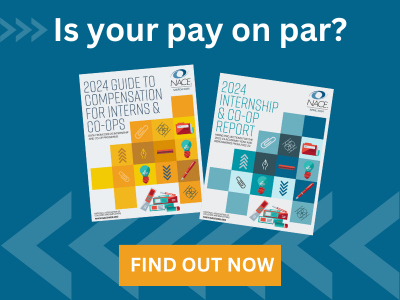Tracking, analyzing, and acting on key metrics is critical to the success of a recruiting operation. Some of the most basic metrics are the interview-to-offer and offer-to-acceptance rates. These can help you identify problems—and successes—in your recruiting operations both with full-time hiring and intern/co-op programs.
Formulas for calculating rates
Interview-to-offer rate = (# of unique offers extended/total number of applicants interviewed) x 100
Currently, the average interview-to-offer rate is 47.5%—approximately 48 of every 100 candidates interviewed received an offer. For example, an organization meeting this benchmark interviewed 200 applicants and extended 95 unique offers; expressed as a formula, this is (95 /200) x 100 = 47.5%.
Offer-to-acceptance rate = ( # of offers accepted/# of offers extended) x 100
The current average offer-to-acceptance rate is 69.3%, meaning approximately 69 of every 100 offers extended were accepted. For example, an organization meeting this benchmark extended offers to 200 candidates, and 138 of those offers were accepted—(138/200) x 100 = 69%.
It is important to acknowledge that there are factors beyond your control that can affect your rates. For example, in a strong economy, the average acceptance rate tends to dip, as candidates have multiple offers to consider. Similarly, if the organization’s brand has taken a hit or the job’s location is an issue, the size of the applicant pool and acceptance rate may be affected. However, organizations do have control over much of what affects these rates.
Get the big picture by tracking over time
A key advantage to tracking all metrics over time is that it gives you the big picture. Year-over-year rates can help you see how your operation is performing long term and help you identify problems so that you can correct the issues and work to avoid the same problems in the future. For example, see a dip in your offer rate? This suggests that you are interviewing a greater number of candidates who do not meet your criteria than was the case previously. What is driving that—what factors that you can control may be contributing to that?
On the plus side, examining your rates over time can also highlight what your operation is doing well so that you can focus resources on that process or effort and demonstrate its value. For example, many organizations have found that, over time, having an internship program to feed full-time hiring efforts results in a better retention rate.
Compare your stats to those of your peers
Benchmarking against others can alert you to a problem so that you can examine—and hopefully correct—the issue.
It can also signal a change that is affecting others as well. For example, you might see that your acceptance rate, while lower than it has been in the past, is in line with others’ rates, suggesting that there are factors outside of your operation that are contributing to the change, e.g., a strong economy, an increase in demand for a particular skill set, and so forth. Note that knowing this does not give you license to ignore the change—you will want to consider what you may be able to do to counter the competition—but it does give you a starting point from which operate.
Additional formulas
There are a host of metrics that can help you strengthen efforts, build on success, and demonstrate the value of your recruiting program. For a detailed list of formulas, including more-sophisticated takes on the interview, offer, acceptance metrics, e.g., application interview rate and applicant to hire rate, see the Professional Standards for University Relations and Recruiting, Chapter III.
Current benchmarks for recruiting, internship/co-op programs
Current recruiting benchmarks are available through the 2022 Recruiting Benchmarks Report; if you or someone at your organization took part, you will find a copy of the report in MyNACE. An executive summary is also available.






